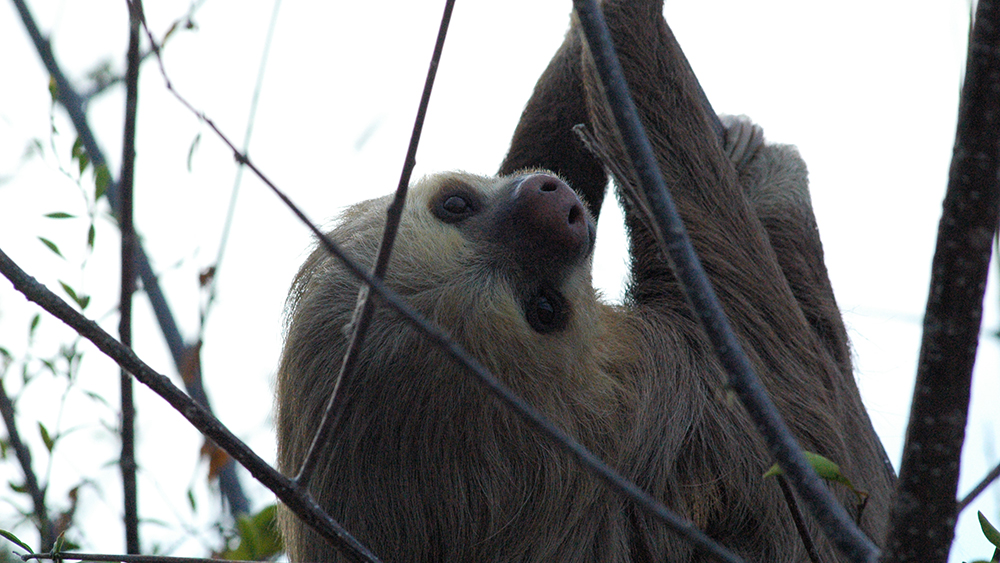
We loved seeing the sloths – they look so endearing and so vulnerable
Crossing the bar leaving Bahia del Sol was even more of a white-knuckle ride than arriving as we were pushing in to the steep face of the waves rather than riding on the gently sloping backs. Surf was crashing in front of us and we were surrounded by white froth. Bill’s voice on the radio said “Slow down and hold your position”. The boat was dipping like a rocking horse as rollers passed beneath us and in the troughs we had less than a metre of water under the keel. We had to wait for the set to pass before we could move ahead to where the waves were breaking. The VHF crackled and Bill’s calmly confident voice said “Ok Neil, now gun it out of there”. We put her in full throttle and were gaining speed but it felt painstakingly slow. We counted the waves and were mighty glad we made it through before the next set reached us.
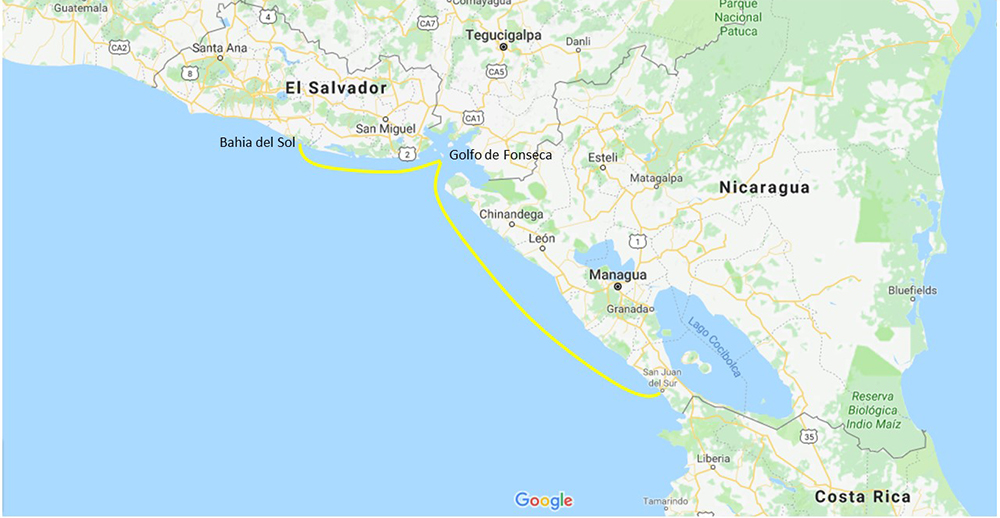
It was 220NM from Bahia del Sol to San Juan del Sur in Nicaragua. Normally we would cover the distance in a single passage spending a couple of nights en route but this time we decided to stop and anchor off the coast each night. Long line fishing nets are common here; the 300-400m net is buoyed with plastic bottles and each end is marked with a float spiked with a flag made from a bamboo pole and a bin liner. They are difficult to spot during the day but impossible at night and we didn’t want to run into one. We broke the journey at Golfo de Fonseca; a huge inlet which borders El Salvador, Honduras and Nicaragua. We couldn’t go ashore as we were not legally in any of the three countries but we spent a few days sailing around the shallow bay and anchoring off the volcanoes which form steep-sided islands where the cones break the water surface.
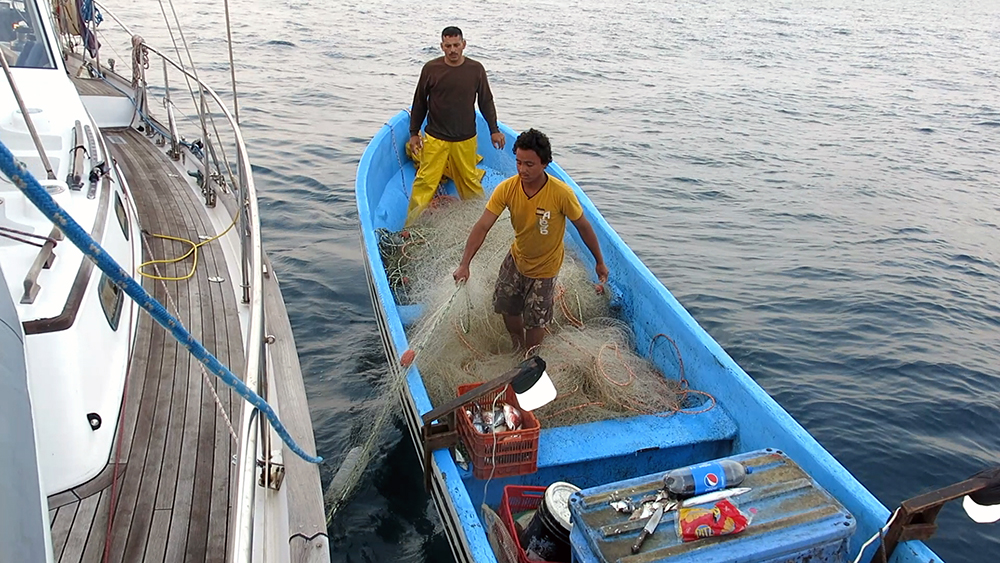
Untangling the fishing net from around our anchor chain
On the third night of the passage down the Nicaraguan coast we anchored off a small fishing village and settled in for the night. At 4am we were awoken by shouts and then the thunk as a panga (local fishing boat) bumped against our hull. Neil got up to find out what was going on; their fishing net had drifted down onto Distant Drummer and got tangled around the anchor chain. Seems like fate had a fishing net with our name on it! There was nothing we could do in the dark so we waited until first light to sort out the mess. After a lot of tugging and hauling, wild gesticulations and expletives we didn’t fully understand the net eventually came free. By then it was 7am and we were wide awake, so we pulled up the anchor and got an early start for San Juan del Sur.
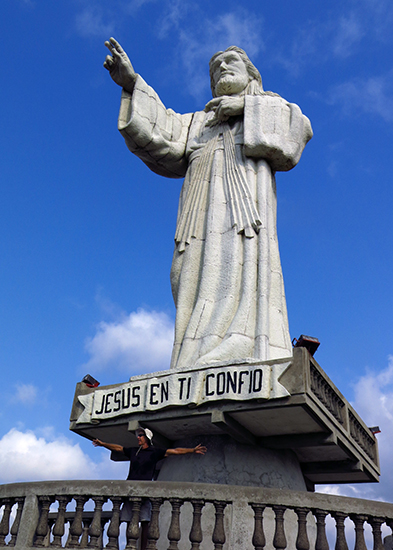
The giant Jesus statue overlooking the bay at San Juan del Sur
Unfortunately Nicaragua has suffered several anti-government protests and riots in the last few weeks and the armed forces have been heavy-handed in dealing with it. We were in two minds about stopping there but since most of the trouble was in the capital city Managua we felt that SJDS should be safe enough. It’s a touristy town populated mainly by surfers and backpackers although every couple of weeks a cruise ship arrives and floods the town with more monied visitors. It’s very laid back with no big resorts or fast food chains, just small hostels, mom-and-pop shops and seafood restaurants on stilts on the beach. The anchorage was open to the Pacific swell and a bit rolly but otherwise it was a great place to spend a couple of weeks.
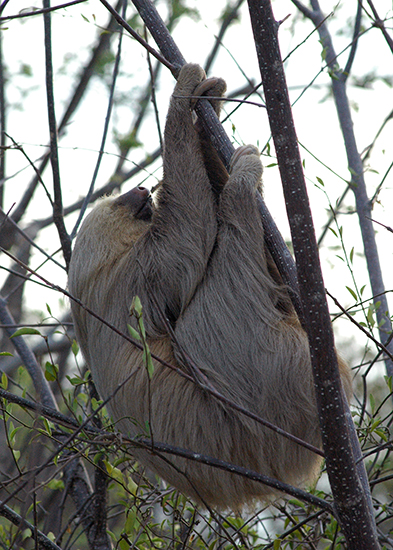
Another sloth photo
For some reason we had expected Nicaragua to be lush and tropical but the vegetation, at least on the Pacific coast is more like savanna with long dry grass, thorny acacia and small spindly trees. Apparently in a few weeks time when the rains come the scrubland will flourish and turn green but the sparse undergrowth did have one advantage; it made spotting sloths much easier. One afternoon we took a hike with a local guide through the bush looking for sloths and we were lucky to see five. Mostly they were hanging in the trees high above our heads but one was only a few metres above the ground and we got to see him up close and personal. Their soulful eyes and listless passivity made them seem very vulnerable but also very cute.
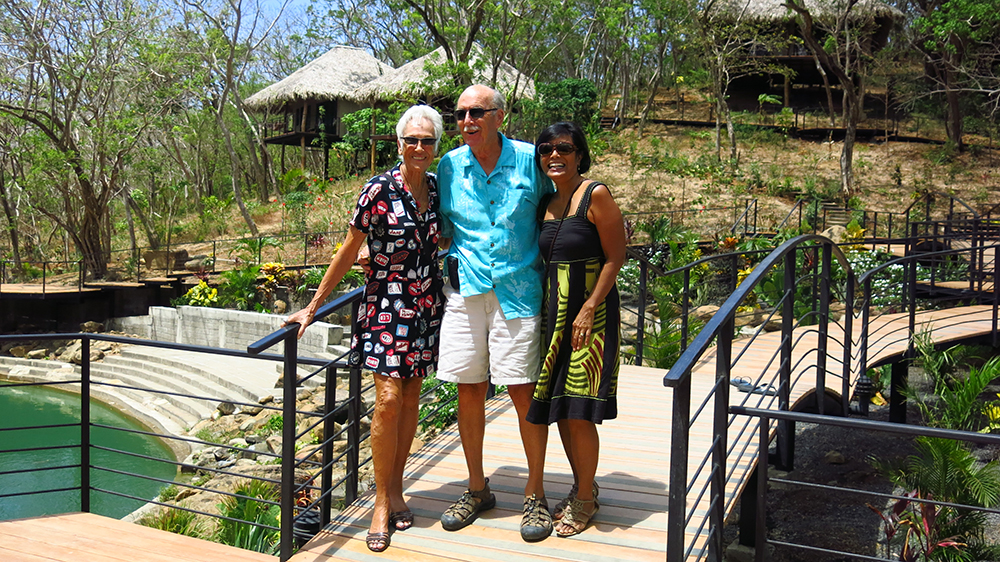
Renda and Ralph and a friend at Tree Casa resort
Life in SJDS turned out to be very sociable. The day after we arrived Lucy and John on Maraki, a northbound yacht, came in and then a few days later a couple of other boats from Bahia del Sol turned up. We also met Ralph and Renda, American locals who built a hotel here twelve years ago and have a boat in the bay. They showed us aroundand introduced us to their friends and we spent several happy evenings drinking Flor de Cana, the local rum, and watching the sun go down behind the giant Jesus statue overlooking the bay.
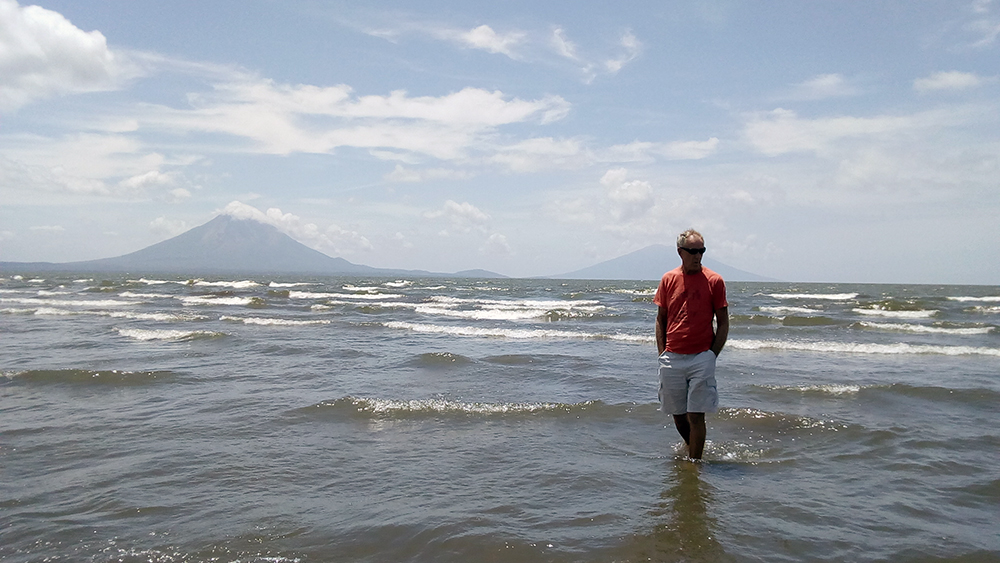
Neil paddling in Lake Nicaragua with Isla Onetepe in the background
Unfortunately travelling inland was pretty restricted due to the unrest which had spread to several other towns and cities outside Managua. Some of the roads were blocked but the barricades migrated in time and space so we were never quite sure which roads were open or closed. We were keen to see something of the country so we hired a car with our friends Tara and Mike on Xenia and set off to see how far we could get. We had great fun hooning along the dirt roads to Rivas and then drove down to Lake Nicaragua to see the stunning double volcano island of Onetepe. Then we hit the Pan American Highway and manged to drive through to the beautiful old colonial city of Granada without and problems.
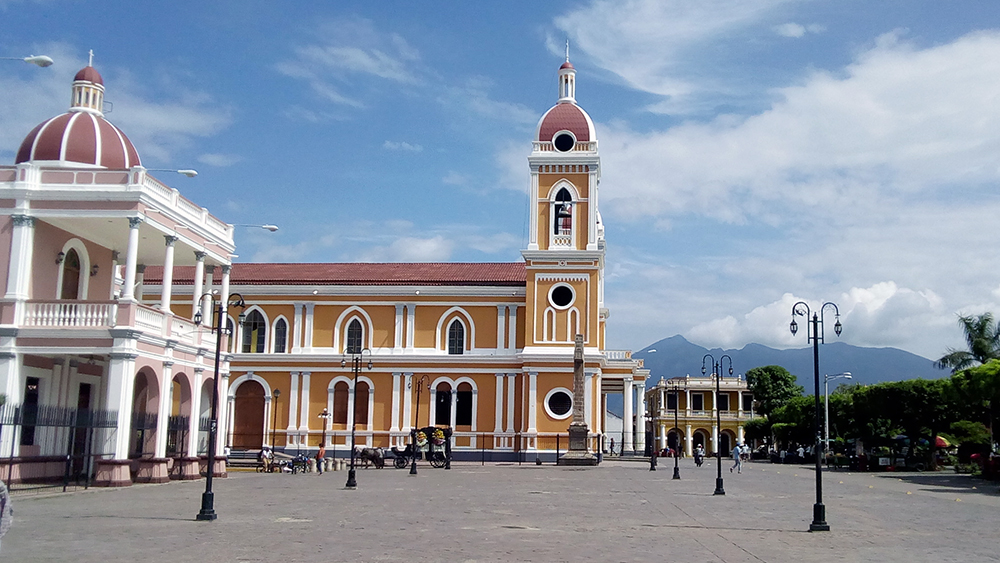
The beautiful cathedral at Granada
Granada lies on the shore of Lake Nicaragua and has been a city of wealth and importance due to it’s access to the Caribbean via the San Juan river. The downside is that it has been sacked several times by pirates (from the Caribbean) but each time it has been rebuilt more beautiful than the last. The churches and other important buildings are very impressive and are all painted in shades from orange to ochre enhancing the consistency and grandeur of the architecture.
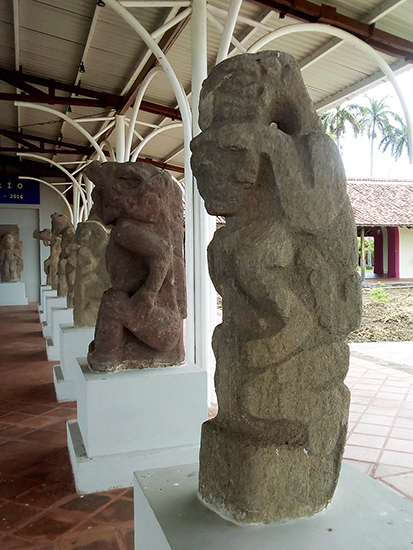
Ancient basalt sculpture moved from Isla Zapatera to a museum in Granada
The city is also home to some amazing statues carved by the tribes that migrated through Central America around 10,000 years ago. The figures are carved out of basalt and have both human and animal forms, similar to the Moai statues on Easter Island. The original statues are now housed in a museum in Granada. They are fascinating to look at but the detail is a little difficult to make out due to thousands of years of weathering at their original site on Isla Zapatera in Lake Nicaragua.
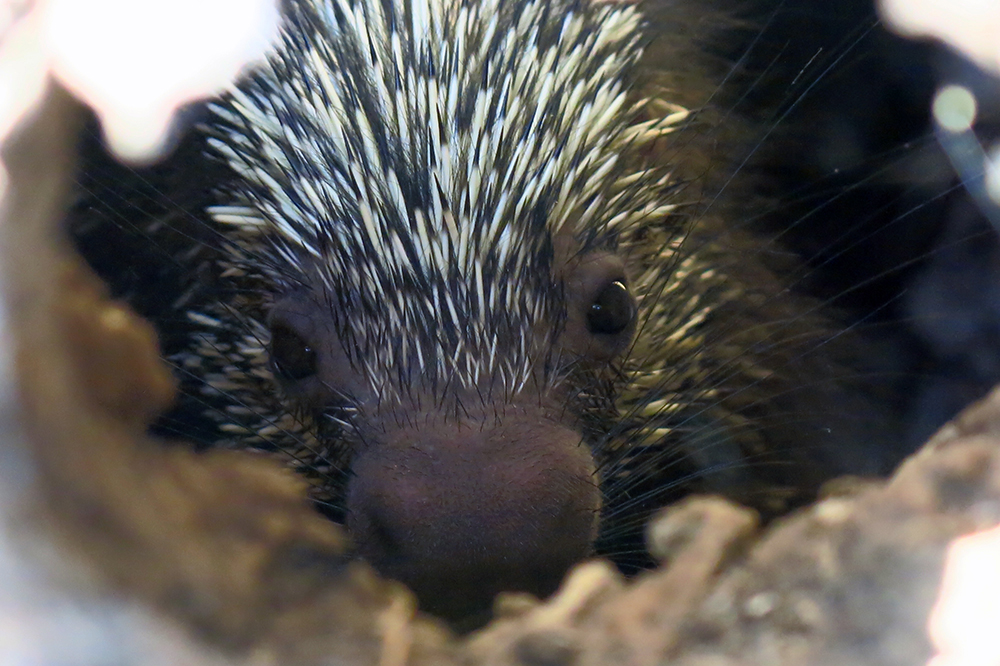
A porcupine hiding in a hole in a tree
Now it’s time to move on again, next stop Costa Rica where we’ll stay for a few months!
Ciao for now, Suzy
